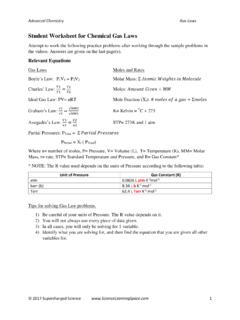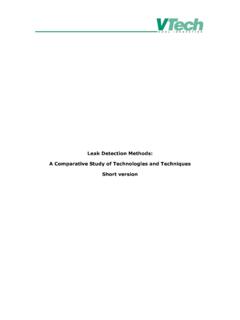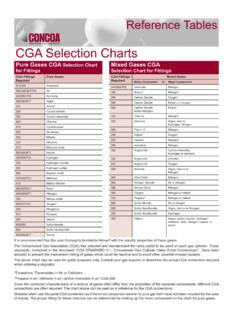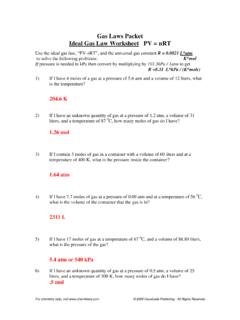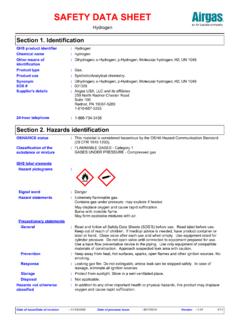Transcription of Gas Chromatography-Mass Spectroscopy - CIRES
1 Gas Chromatography-Mass Spectroscopy Introduction Gas Chromatography-Mass Spectroscopy (GC-MS) is one of the so-called hyphenated analytical techniques. As the name implies, it is actually two techniques that are combined to form a single method of analyzing mixtures of chemicals. Gas chromatography separates the components of a mixture and mass Spectroscopy characterizes each of the components individually. By combining the two techniques, an analytical chemist can both qualitatively and quantitatively evaluate a solution containing a number of chemicals. Gas chromatography In general, chromatography is used to separate mixtures of chemicals into individual components.
2 Once isolated, the components can be evaluated individually. In all chromatography , separation occurs when the sample mixture is introduced (injected) into a mobile phase. In liquid chromatography (LC), the mobile phase is a solvent. In gas chromatography (GC), the mobile phase is an inert gas such as helium . The mobile phase carries the sample mixture through what is referred to as a stationary phase. The stationary phase is usually a chemical that can selectively attract components in a sample mixture. The stationary phase is usually contained in a tube of some sort called a column. Columns can be glass or stainless steel of various dimensions. The mixture of compounds in the mobile phase interacts with the stationary phase.
3 Each compound in the mixture interacts at a different rate. Those that interact the fastest will exit (elute from) the column first. Those that interact slowest will exit the column last. By changing characteristics of the mobile phase and the stationary phase, different mixtures of chemicals can be separated. Further refinements to this separation process can be made by changing the temperature of the stationary phase or the pressure of the mobile phase. Our GC has a long, thin fused silica column containing a thin interior coating of a solid stationary phase (5% phenyl-, 95% dimethylsiloxane polymer). This mm diameter column is referred to as a capillary column.
4 This particular column is used for semi-volatile, non-polar organic compounds. The compounds must me in an organic solvent. The capillary column is held in an oven that can be programmed to increase the temperature gradually (or ramped), this helps separation. As the temperature increases, those compounds that have low boiling points elute from the column sooner than those that have higher boiling points. Therefore, there are 1. actually two distinct separating forces, temperature and stationary phase interactions mentioned previously. As the compounds are separated, they elute from the column and enter a detector. The detector is capable of creating an electronic signal whenever the presence of a compound is detected; the greater the concentration in the sample, the bigger the signal.
5 The signal is then processed by a computer. The time from when the injection is made (time zero) to when elution occurs is referred to as the retention time (RT). For optimum column efficiency, the sample should not be too large, and should be introduced onto the column as a "plug" of vapor - slow injection of large samples causes band broadening and loss of resolution. The most common injection method uses a micro- syringe to inject sample through a rubber septum into a flash vaporizer port at the head of the column. The temperature of the sample port is usually about 50 C higher than the boiling point of the least volatile component of the sample. Since capillary columns need very little sample, split/splitless injection mode is used.
6 The injector contains a heated chamber containing a glass liner into which the sample is injected through the septum. The carrier gas enters the chamber and can leave by three routes (when the injector is in split mode). The sample vaporizes to form a mixture of carrier gas, vaporized solvent and vaporized solutes. A proportion of this mixture passes onto the column, but most exits through the split outlet. The normal GC injector configuration is split mode as seen left. In this example, a total flow of 49. ml/min comes into the injector from the pressurized carrier gas tank (He is most common; N2 is cheapest but chromatographically less forgiving). Note that the total gas flow flows: 1) through the column (green thing at bottom), 2) out the septum purge, and 3) out the split vent and always add up to the incoming flow, 49 ml/min in this example (1 + 2 + 46 =.
7 49 ml/min). As the above image shows the gas flow passes through the septum purge and the split vent and some of the sample injected into the injector will get vaporized and escape through the split vent. In this example, the split ratio is 1/49 because 49 parts are injected and 1 part goes on column. 2. For trace analysis split injection is used. In this mode, the entire analyte sample vaporized in the injector goes onto the column. This is called the splitless mode. All the analyte mass in a 1 l injection goes onto the column, it is not split. Finally, the septum purge outlet prevents septum bleed components from entering the column. The constant septum purge flow sends clean, carrier gas past the bottom on the septum and out to waste (in this example it is 2 ml/min in whatever mode (splitless or split) the analyst uses).
8 This helps keep the septum clean and prevents sample adsorbed on the septum from getting into the gas in the injector thus creating ghost peaks; that is, analyte peaks that are carried-over from one injection where their concentration is very high to another where they are not supposed to be at all. While the instrument runs, the computer generates a graph from the signal, called a chromatogram (see figure 1). Each of the peaks in the chromatogram represents the signal created when a compound elutes from the GC column into the detector. The x-axis shows the RT, and the y-axis shows the intensity (abundance) of the signal. In Figure 1, there are several peaks labeled with their RTs.
9 Figure 1: Chromatogram generated by a GC. If the GC conditions (oven temperature ramp, column type, etc.) are the same, a given compound will always exit (elute) from the column at nearly the same RT. By knowing the RT for a given compound, we can make some assumptions about the identity of the compound. However, compounds that have similar properties often have the same retention times. Therefore, more information is usually required before an analytic al chemist can make an identification of a compound in a sample containing unknown components. 3. mass Spectroscopy As the individual compounds elute from the GC column, they enter the electron ionization ( mass spec).
10 Detector. There, they are bombarded with a stream of electrons causing them to break apart into fragments. These fragments can be large or small pieces of the original molecules. The gas molecules exiting the GC are bombarded by a high-energy electron beam (70 eV). An electron which strikes a molecule may impart enough energy to remove another electron from that molecule. Methanol, for example, would undergo the following reaction in the ionizing region: . CH3OH + 1 e- CH3OH+ + 2 e- . (The symbols + indicate that a radical cation was formed). Electron impact Ionization (EI) usually produces singly charged ions containing one unpaired electron. A. charged molecule which remains intact is called the molecular ion.



